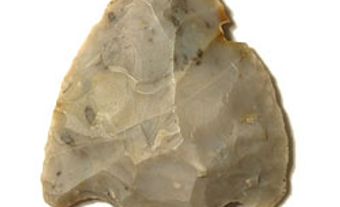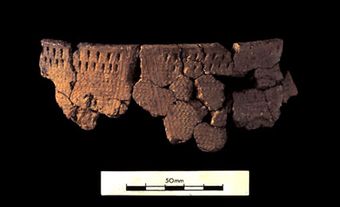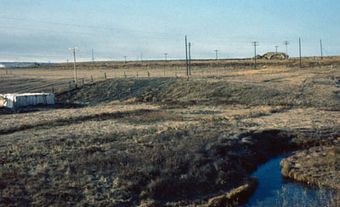Archaeology in Québec
Archaeology in Québec really took off between 1960 and 1970, during the sociocultural movement known as the Quiet Revolution. This was the time when Québécois created their first official structures to facilitate training (university programs), management (Archaeology and Ethnology Service of the Québec government), activities (numerous archaeological societies) and popularization (Musée de Trois-Rivières, Cahier d'Archéologie Québécoise). There had previously been occasional digs, private collections and individuals interested in the archaeological riches of the province, but it was only in the 1960s that the discipline acquired continuity, growth and professionalism. At that time there was much to do and few resources with which to do it. In practice, it was a decade of apprenticeship and enumeration.
One of the most important events of this period was the creation of the Société d'archéologie préhistorique du Québec (SAPQ). It brought together a dynamic group of volunteers, moved by their desire to give Québec archaeology the highest possible standards. One must also acknowledge the extensive work done by J. Pendergast and the pioneering activities of M. Gaumont, R. Ribes, C. Martijn, R. Lévesque and C. Kennedy.
The 1970s
This was the golden age of Québec archaeology. Research programs in the field were developed, legislation on cultural property was enacted, and the Québec Association of Archaeologists (AAQ) was created. université de Montréal set up a field school on the site of the Pointe-du-Buisson at Beauharnois (since 2001, it has been moved to a site known as the Méganticois). These were also the years when firms of consultants set up, and huge projects resulting from legislation on town planning and environmental quality were initiated in the James Bay region, Ungava (the Tuvaaluk Project), the Gaspé Peninsula, and in the Montréal area. Many digs were also carried out elsewhere, and major work was done at Place Royale in Québec and in the Forges Saint-Maurice.
These methodical works produced great quantities of data and detailed research reports were published in periodicals such as Recherches amérindiennes au Québec and Inuit Studies, in the Dossiers et Cahiers du Patrimoine, published by the Department of Culture and Communications, and in Paléo-Québec. It became clear that Québec contained a rich record of both prehistoric and historic vestiges that still remained largely unknown. More than a cultural novelty, archaeology was now an integral part of Québec's intellectual life.
The 1980s
This period was one of consolidation. Several large field projects came to an end and led to analysis and synthesis. université du Québec in Montréal opened a field school in Grandes-Bergeronnes (it is now closed), and université Laval also got one at the Palais de l'Intendant, a historic site located in the heart of Québec City (in the 1990s the field school was moved to îlot Hunt and then to the Domaine Maizeret, before returning to the Palais de l'Intendant in 2000). Parks Canada carried out excavations under the Dufferin Terrace in Québec between 1985 and 1987, a large project that was revived in 2005.
Established in 1982, the Ostéothèque of Montréal acquired a reference collection that presently counts 600 animal skeletons, and has since identified faunal remains from hundreds of archaeological sites. The Centre de conservation du Québec offered an expertise for the restoration of artifacts and an interpretation centre was built on the site of Pointe-du-Buisson. A large data acquisition project took place on the Lower North Coast, while the Lac Saint-Jean area was closely examined by Université du Québec in Chicoutimi. The Québec Department of Transportation hired an archaeologist who has since assumed the task of managing archaeological resources within the road network and northern airport infrastructures. It was also during this period that the regional Cree administration (James Bay) established its archaeology program. Indigenous peoples also raised questions about the ownership of archaeological collections in Northern Québec, the treatment of human burials threatened by land-management activities, and the interpretation of the past. This significantly modified their relationship with the scientific community.
The 1990s
The 1990s were a period of introspection and a desire for a greater coherence among the professional community. There was a decline in the labour market with the suspending of large hydroelectric projects financed and supervised by Hydro-Québec, and smaller funds from the Department of Culture and Communications. Nevertheless, lesser projects continued to take place throughout the province. For instance, the question of the first peopling of Québec in the Témiscouata, the Gaspé Peninsula and around Québec City was explored. A series of investigations was carried out in Abitibi by a corporation of archaeologists from the region. The Iroquoian universe was also studied at both ends of the St Lawrence valley, at the mouth of the Saguenay River and in Saint-Anicet. Archéo Topo's interpretation centre in the Grandes-Bergeronnes opened its doors in 1995, and the Nisula Rock art site on the Higher North Coast was studied under the patronage of an Innu community.
During this period, the greater reliance on investigation techniques originating from nuclear physics opened the door to new interpretations. The sources of raw materials used for the fabrication of pottery, copper or stone items were identified and contributed to recreate the supplies networks and movement cycles of human populations. Works carried out in the underground infrastructures of historic districts in Montréal, Québec and TROIS-RIVIÈRES were closely monitored and represented the first income source of private archaeology firms. Archaeological publications grew in number, bearing testimony to the dynamism of researchers (eg, Mémoires vives, Archéologies québécoises, ArchéoLogiques, Cahiers d'archéologie du CÉLAT). A movement for popular education also emerged through the efforts of the organization Archéo-Québec, which provides access to dozens of archaeological sites during the summer. The Museum of Archaeology and History of Pointe-à-Callières was inaugurated in 1992 on the site where the foundation of Montréal began. In 2002, the Museum started a field school for students from the anthropology department at Université de Montréal. In 2002, Université Laval opened a second field school in historic archaeology in LA PRAIRIE, close to Montréal. A third one also started at Île d'Orléans in 2003.
Retrospect
Prehistoric archaeology provides a better understanding of different aspects related to the way of life of Québec's ancient Indigenous populations, whose presence goes back 11 000 years. It represents the first source of substantial documentation about the old division of the territory between the three Indigenous groups that inhabited it when Europeans arrived: the Inuit, the Algonquians and the Iroquoians (see Indigenous People: Eastern Woodlands). It shows their similarities and differences from neighbouring populations. It interacts with ethnohistory, ethnoarchaeology and various other sciences that also seek to understand the past. Historical archaeology, more visible and spectacular, offers a compelling look at different aspects of Québec society's more recent past. With the help of historical documents, it deeply re-examines French colonization, commerce, technology, farming practices, and the military and industrial fields.
In sum, since the 1960s archaeology in Québec has written a first chapter in the prehistoric and historical fields, and this in a territory that is as big as France, Spain, Italy and Greece together. Even though the development of the discipline mostly takes place in French, which may prevent a more widespread appreciation, it remains nevertheless essential to the creation of a Québec tradition in archaeology.

 Share on Facebook
Share on Facebook Share on X
Share on X Share by Email
Share by Email Share on Google Classroom
Share on Google Classroom




